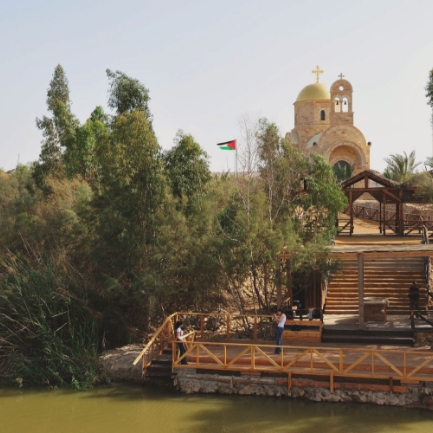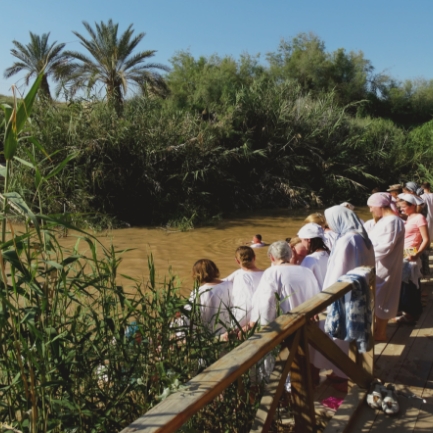
Many varied customs accompanied the pilgrimage in the Old Testament. With Josiah's reform, celebrations at local temples were canceled, and the festival became unified and centralized for Easter. With the advent of Jesus Christ, worship transcended places and structures, becoming worship "in spirit and truth." However, this does not preclude the fact that places that have witnessed the history of salvation can be a place for pilgrimage for Christians throughout the ages, being a destination for spiritual reflection and a source of prayer that assists the faithful in the march of his earthly pilgrimage towards the heavenly homeland.


The pilgrimage in the Old Testament was accompanied by different customs "such as wiping with oil" (Book of Genesis 28:18) or the practice of certain cleansings of washing and replacing clothes (Book of Genesis of 25:3) or they provided money (Book of Genesis 28: 20-22). Sacrificial offerings were often associated with pilgrimage. In Genesis, for example, we read: "Then Jacob offered sacrifice upon the mount, and called his brethren to eat bread: and they did eat bread, and tarried all night in the mount (Genesis 31:54)
With the reform of Josiah (2 Kings 23: 1-2) celebrations at local temples were canceled, and the celebration became a major central celebration in Jerusalem, for the Easter occasion. The aim of that reform was to reunite the people before their God. Jerusalem's structure became the only indisputable temple. For the Grand Holidays, the pilgrims came to the structure from all over Palestine, and also from the Jews of the diaspora.
The pilgrims were reaching as groups to the structure, and they were sounding Psalms. The pilgrimages Psalms (from Psalm 120 to 134) express the tourist's feelings and faith and attach him to the House of God and to the Holy City, and explain the meaning of his beliefs including prayer, prostration, and request for blessing or comfort and the repentance. The believer's highest aspiration is unity through collective pilgrimage and one company in prayer.
We see Jesus at the age of 12 with his parents to Jerusalem, out of respect for the order of the Shariah (Luke 2: 41-42). Jesus was ascending to Jerusalem on the big holidays throughout his message. For example, we read in St. John's Gospel: "And the Passover of the Jews was near, and Jesus went up to Jerusalem" (John 2:13, and also John 5:1). Jesus rejected false pilgrimages unrelated to spirit and right, and expelled vendors from the temple.


It's an invitation to do Abraham's march. Go: This requires the faithful to leave his house, that is, leave his stability and sufficiency to take an adventure with God. Abraham became the Father of the faithful because he responded to the call of the Lord, who told him: "Go from your land, clan, and house of your Father to the land that I show you" (Book of Genesis 21). Abraham believed in the word he heard and relied on God's promise to him and walked. And so it is the case for every believer: his launch is a sign of abandonment of stability and self-departure. This is the pilgrimage required. The Catholic Church's teaching stated: "The pilgrimage reminds us of our march on earth towards heaven. It is a time tradition for a strong renewal of prayer. The temples are, for pilgrims seeking their living springs, exceptional places to live ecclesiastically in Christian prayer patterns.


The pilgrim has to go the distance, and take a path that is interspersed with various stations, and is not without hazards and tribulations. In his career, he must dispense with all that is unnecessary, and rely on God's blessing. This is similar to Jesus' own march from Galilee towards Jerusalem; He passed it relying his father, overcoming all the obstacles and tribulations. "Entering God's House presupposes passing a threshold that is the symbol of transit from the sin-thickened world to the world of eternal life to which all of the people are invited."


Pope Paul II says in his letter, pilgrimage to places associated with the history of salvation: "Temples do not claim that the Lord is in a particular place but (...) symbolizes that God resided among his people in Jesus and that Mary is his mother on a permanent visit to the world ". Listening to Jesus' Word and sharing in secrets and remembering it is still as the "entrance to" residence "in God and life with him.


Pilgrimage is the time to return to assets, to springs, and the time to lay the foundations. But this return never means shirking the present time, but, otherwise, living at the heart of everyday life. The march of the Christian "pilgrimage" brings the believer back to the heart of his world and church. Therefore, in the end; the pilgrimage is to adopt Jesus' message and follow in his footsteps for the realization of the Kingdom of God. This pilgrimage journey is lived by the faithful, relying on Christ resurrecting among people, reflecting peace and power: "Do not be afraid"; I'm with you, peace with you... This is how the faithful bear the mercy, "the secret to our salvation."

Traveling in ancient Palestine was very harsh, as most of the pilgrims traveled on foot, and only the rich owned animals. Then the roads were subject to various dangers such as bandits and predators, as well as thirst and hunger. But some pilgrims were not satisfied with facing these dangers and preferred to fast during their pilgrimage for a period of between 15 and 20 days, and some of them were sharpening, and others did not carry with them only a little bread and vegetables and a small amount of money. When they reached the place of worship, they offered offerings and spent the night in prayer.
The Church has abandoned all the ranks or the semi-ranks that were followed
Read more ...
With the advent of Christ, worship went beyond places and structures altogether, becoming "worship in spirit and truth" (John 4:24). However, this does not preclude the places where Jesus lived and was crucified and resurrected to be important to believers such as the places where saints lived and witnessed their faith, places where religious munitions were kept or included the shrines of martyrs and saints, and places of pilgrimages.
Saint John Paul II says: “When we move in a spirit of prayer from one place to another, and from one city to another, in this space distinguished by divine intervention, this not only helps us to live our lives in a way, but also provides us with the idea that a God walked before us and preceded us, and he will walk on the paths of man, a God who does not look at us from above, but has become our companion on the path."
Deep pilgrimage remains an internal and spiritual willingness to repent. This requires three basic integrated attitudes to live: